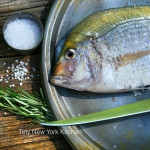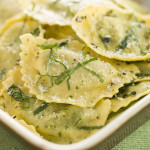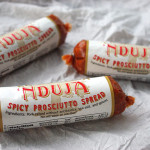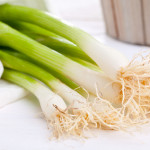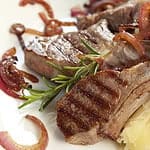A Fish Bone In Your Throat?
If you miss a bone and don’t discover it until it’s halfway down your throat, don’t panic. Bite off a piece of bread, chew and swallow it. It will take the bone with it, out of harm’s way.
“Work With What You Got!”
© Victoria Hart Glavin Tiny New York Kitchen All Rights Reserve
Basic Seafood Cooking Rules
Keep your fish or shellfish in the refrigerator until right before you cook it to keep it as fresh as possible. Don’t leave it siting on the counter while you prepare the rest of the meal.
Don’t work in the same area with raw seafood and cooked seafood. There is too much danger of cross contamination.
Cook seafood with the skin on whenever possible and appropriate. It helps fillets and steaks hold their shape and keeps moisture in whole fish. Make two or three shallow slashes across the skin of the fillet or whole fish to prevent the fish from curling while cooking.
If you are baking fish that is of different thicknesses, as in fillets that taper to very thin ends, fold the thin ends under so they won’t overcook.
Try to turn fish just once, if at all, during the cooking process so there is less risk of it falling apart.
If cooking fish in a coating or batter, use small or thin pieces so both batter and fish cook at the same rate.
“Work With What You Got!”
© Victoria Hart Glavin Tiny New York Kitchen All Rights Reserved
Spring Ravioli
Capture springtime on the plate with fresh ravioli enveloping a purée of sweet English peas that is bolstered with a touch of cheese and herbs. Simmer these ravioli for just a few minutes, drain (but not too thoroughly) and add a couple of tablespoons of butter to the pan. Once the butter melts, return the ravioli to the pan, add a bright toss of lemon zest and season with salt and pepper. Some grated Parmesan and slivers of fresh mint or a handful of pea shoots are worthy embellishments.
“Work With What You Got!”
© Victoria Hart Glavin Tiny New York Kitchen All Rights Reserved
Hard-Boiled Eggs
Banish the greenish ring! This harmless, but unsightly discoloration that sometimes forms around hard-boiled yolks results from a reaction between sulfur in the egg white and iron in the yolk. It occurs when eggs have been cooked for too long or at too high a temperature. The method of cooking eggs in hot, not boiling water, and then cooling immediately, minimizes this from happening.
Food safety precaution: Piercing shells before cooking is NOT recommended. If not sterile, the piercer or needle can introduce bacteria into the egg. Also, piercing creates hairline cracks in the shell, through which bacteria can enter after cooking.
Never microwave eggs in shells. Steam builds up too quickly inside and eggs are likely to explode.
Very fresh eggs can be difficult to peel. To ensure easily peeled eggs, buy and refrigerate them a week to 10 days in advance of cooking. This brief “breather” allows the eggs time to take in air, which helps separate the membranes from the shell.
Hard-boiled eggs are easiest to peel right after cooling. Cooling causes the egg to contract slightly in the shell.
To peel a hard-boiled egg gently tap the egg on your countertop until the shell is finely cracked all over. Roll the egg between hands to loosen the shell. Start peeling at the large end, holding the egg under cold running water to help ease the shell off.
Storage: In the shell, hard-boiled eggs can be refrigerated safely up to one week. Refrigerate in their original carton to prevent odor absorption. Once peeled, eggs should be eaten that day.
High altitude cooking: It’s almost impossible to hard-cook eggs above 10,000 feet.
“Work With What You Got!”
© Victoria Hart Glavin Tiny New York Kitchen All Rights Reserved
Fresh Spinach
Spinach is available year round, but is especially sweet and tender in the late spring, when growing conditions are perfect.
Spinach is so versatile; you can eat it for breakfast, lunch, dinner, and dessert! In Tuscany, the leaves are baked into a pie with almonds, sugar, and candied lemon peel called torta co’bischeri agli spinaci. Leave it to the Italians to create a spinach dessert.
http://www.npr.org/2013/03/28/175478107/tuscan-pie-a-sweet-springtime-take-on-spinach
When shopping for spinach the leaves should be crisp and free of moisture. Avoid spinach with broken or bruised leaves.
If you purchase bagged greens (yes, I know there is a big controversy on bagged greens) they will most likely last twice as long as the leafy bundles. Bagged spinach is handled less and exposed to less moisture. Make sure to check the “best by” date to use the leaves when they are at their peek. If they are dark or clump together, just pass them by.
Spinach grows in sandy soil, so if you by bundled spinach it most definitely won’t be prewashed. Just give the leaves a generous soak in cold water, changing it out once or twice, until there is no more grit in the bottom of the bowl.
To Prepare Spinach (1 Pound): Wash and drain. Remove stems and tear into pieces (12 cups torn).
Conventional Cooking Directions: Cook, covered, in a small amount of boiling salted water for 3 to 5 minutes or until tender. Begin timing when steam foams. OR steam for 3 to 5 minutes. Microwave cooking is not recommended.
How To Store: Rinse leaves in cold water and thoroughly dry. Place leaves in a storage container with a paper towel and refrigerate for up to 3 days.
Baby Spinach isn’t actually immature flat-leaf spinach, but a different variety entirely.
Flat-Leaf Spinach has large leaves that turn silky once slow cooked. They have an earthy flavor that tastes great in dishes like lasagna or soup.
It takes 8 cups of raw spinach to make just 1 cup of cooked. Make sure that you have enough spinach for your recipe.
Raw spinach has 33 percent more folate and 187 percent more vitamin C than cooked, since those nutrients are vulnerable to heat. On the flip side, cooking spinach deactivates oxalic acid, a compound that prevents the absorption of certain nutrients, so you get 32 percent more iron and nearly 40 percent more calcium than raw. Have a salad today and sauté tomorrow.
“Work With What You Got!”
© Victoria Hart Glavin Tiny New York Kitchen All Rights Reserved
Spreadable sausage from Norwalk, Iowa? The culinary creativity across the country never ceases to amaze me. Nduja is a spreadable sausage that comes from Calabria in southern Italy. My husband is Calabrian so it goes without saying that I love all things from Calabria. La Quercia, the cured meat producer in Iowa has introduced its American-made version, which is a mix of prosciutto, speck, and red chili peppers. It comes in five ounce links and is extremely versatile. Use it in pasta sauce, grilled cheese, BLTs, egg salad, burgers, pizza, crostini, or tacos. It’s also wonderful slathered on warm bread or crackers.
If you’re in New York City you may find it at Fairway, Amish Market, or Murray’s Cheese. If you’re in other parts of the country then go to La Quercia’s website for store locations. http://laquercia.us
“Work With What You Got!”
© Victoria Hart Glavin Tiny New York Kitchen
Storing Baked Goods
Always allow baked goods to cool completely (preferably on a wire rack) before wrapping and storing. If they are wrapped before they are thoroughly cooled, pastries will steam, turning their nice crisp surfaces soggy and limp. The texture and flavor of most baked goods fare best when stored, well wrapped, in a cool dry location for a couple of days. However, those that are particularly high in moisture will be safest stored in the refrigerator.
“Work With What You Got!”
© Victoria Hart Glavin Tiny New York Kitchen
Ramps
If you can’t find any of those oh-so-fleeting ramps at your local farmers’ market then have no fear, as there are plenty of other onion options available this time of year. Turn to Tiny New York Kitchen’s favorites.
Scallions: A supermarket staple. They have a peppery bite that isn’t overpowering. Scallions (Green Onions) are best used chopped raw or charred in salads or as a garnish.
Leeks: Leeks have a slight garlic flavor that mellows when cooked. Braised to an almost creamy texture, they are one of the best side dishes.
Spring Onions: Spring onions are a more mature scallion with large, sweet bulbs and pungent, spicy green tops. They are excellent for roasting whole and finished with sea salt and s bit of lime juice.
Flowering Chives: These mature chives are bursting with gorgeous purple flowers that taste just like wonderful chives. Use both flowers and finely cut stems in salads.
“Work With What You Got!”
© Victoria Hart Glavin Tiny New York Kitchen
Cooking Ham
Ham is a great choice for spring gatherings. It’s simple, feeds a crowd and provides wonderful leftovers.
Keep Servings In Mind. Allow for 1/2 to 3/4 pound per serving for bone-in ham, and 1/4 to 1/2 pound per serving for boneless ham.
Before Cooking make sure to let ham sit at room temperature for approximately 1 hour.
Scoring The Skin adds to a beautiful presentation. Cut 1/4 inch deep crosswise into 1 to 2 inch squares to create classic diamond shapes.
Glaze The Ham during the final hour of cooking to avoid burning.
Keep The Flavor Going. Buying bone-in ham leaves you with the ham bone, which is great for flavoring soups and beans.
“Work With What You Got!”
© Victoria Hart Glavin Tiny New York Kitchen
Cooking Lamb
Lamb is versatile and can be prepared quickly for a spur-of-the-moment gathering or roasted to perfection and served with a range of accompaniments.
Let The Cut Determine The Cooking Technique. For tender cuts like a rack, chops, loin, sirloin, or leg it’s best to broil, roast, grill, pan fry or sauté. For less tender cuts like shank or shoulder roast it’s best to braise or stew.
Store Lamb For 1-2 Days In The Refrigerator. Or you may freeze for up to 3 months. Thaw slowly in the refrigerator for a day or two before cooking.
Get Creative With Spice Rubs. Mix garlic, ginger, cardamom, cloves, chili pepper, and fenugreek for an Ethiopian style spice rub. Or create your own custom blend.
Always Test Doneness With A Meat Thermometer. Cook ground lamb to at least 160 degrees and other cuts to at least 145 degrees.
Make “Spring Burgers” With Ground Lamb. Season with dill, mint, or rosemary. Top with chopped fresh tomatoes and feta cheese.
“Work With What You Got!”
© Victoria Hart Glavin Tiny New York Kitchen


